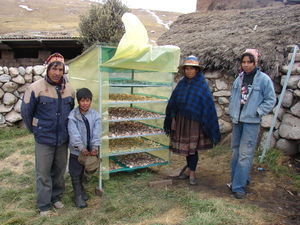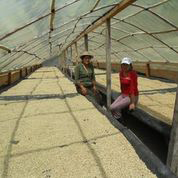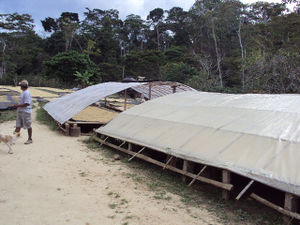Click here to register!
Solar Drying
HERA Cooking Energy Compendium --> Back to Overview GIZ HERA Cooking Energy Compendium
Introduction
Preservation of agricultural produce is one of the central problems faced by developing countries. And as time goes on, these problems will be aggravated by the growing dietary needs of these countries increasing populations.[1]
In many developing countries large quantities of fruits and vegetables spoil due to inadequate infrastructure, insufficient processing capacities, and growing marketing difficulties caused by intensifying competition and protectionism in the worldwide agricultural markets. Up to 70 per cent of agricultural products spoil during the traditional process of open-air drying, especially in tropical and subtropical regions.[2] Drying these products can help solve these problems, while also making an important contribution to improving the population's income and supply situation.
Drying is an important form of food preservation that is often carried out at farm level right after harvest, or especially with highly perishable crops, at peak harvest time when local markets are saturated. Drying vegetables, fruits and meat with thermal energy enables longer storage times and easier transportation. Up to 70 per cent of agricultural products spoil during the traditional process of open-air drying, especially in tropical and subtropical regions (INNOTECH, 2012).
Agricultural products can be dried open-air or unimproved, directly in the sun, with biomass or in solar dryers.
Open-air or unimproved drying takes place when food is exposed to the sun and wind by placing it in trays, on racks, or on the ground. The advantage of drying products directly open-air is that almost no costs for fuel and appliances have to be spent by the farmer. However, the dried products are often of lower quality due to varying temperature levels and contamination of the products with dust, vermin’s and leafs.[1]
Solar Dryers
Solar dryers require a certain investment for the set-up of the appliance, but no expenditures for the fuel. The basic function of a solar dryer is to heat air to a constant temperature with solar energy, which facilitates extraction of humidity from crops inside a drying chamber. Ventilation is enabled at a constant rate through defined air inlets and outlets, small solar ventilators or temperature difference, either due to exposition or vertical height. In direct sun driers the food is put in boxes with a transparent lid. Additionally, the temperature in the drier is raised due to the greenhouse effect and the air exchange is regulated by vents. The food is not exposed to direct sunlight in indirect sun driers as the fresh air is heated separately from the food chamber. This method is preferable for drying foods which loose nutritional value when exposed to direct sunlight. Hybrid driers combine solar energy with a fossil fuel or biomass fuel (Green and Schwarz, 2001a).
A first step when considering solar drying is to compare the different drying options available. Solar drying will only be successful, when it shows tangible benefits in comparison to existing drying methods. In comparison to the traditional way of drying outside in an open field, solar dryers prevent contamination of produce by dust, insects, etc., thereby ensuring quality. They allow small-scale farmers to transform their harvest into storable and tradable goods, which they can sell off-season at higher prices. The constant temperature and ventilation allows a consistent drying process which results in better product quality and higher prices. However, the investments costs of solar dryers vary highly depending on the size of the solar dryer, locally available materials and environmental conditions, such as slope and exposition of the side, rainy seasons.[3][4]
| Picture: Solar drying in Bolivia (Natalie Pereya, GIZ EnDev Bolivia) |
Different types of solar driers, their installation and usage are well descriped at http://www.gate-international.org/energy.htm
The Hohenheim‖-type solar tunnel dryer combines simple construction, use of renewable energy and easy handling. The model is equipped with a photovoltaic (PV) driving fan with a power requirement of 20-40 W. The thermal energy gained from solar radiation is up to 60 kWh/day (equivalent to 15 kg of firewood). As a cooperative development between the Institute for Agricultural Engineering in the Tropics and Subtropics of Hohenheim University and INNOTECH Engineering Ltd., solar tunnel dryers are in commercial operation in more than 60 countries all over the world.[5]There is a guidance paper on how to install a solar tunnel dryer with explanations and pictures, available at: http://www.ats.uni-hohenheim.de/_deutsche_site/projekte/_pdf/Guidance.pdf.
Promoting Solar Drying in Peru
Energising Development Peru promotes solar dryers among individual smallholder coffee farmers for the first drying period, during which the humidity of the beans is reduced to around 25 per cent. The solar dryer improves the drying process by filtering UV radiation, concentrating heat, reducing the relative humidity of the air and thus drying the beans with constant and natural ventilation. However, coffee can only be stored and exported at a lower level of humidity. A second drying phase is therefore required, that reduces the humidity of the beans to around 12 per cent; this phase takes place in a bigger solar dryer with a capacity for up to 2 tonnes of coffee, which is managed by farmers’ associations.
Example: Small holder farmer increases income with solar dryer
Victoria Esteban Fuentes has a farm of two hectares in Santa Anita, Satipo, Peru. Before the adoption of the new solar dryer, approximately 70 per cent of Victoria’s coffee harvest met export standards. The solar dryer has increased this rate by eight per cent. Victoria’s income has therefore increased by PEN 2,400 (USD 885) or 30 per cent per annum. The investment in an efficient solar dryer certainly paid off for her.
| Picture: Victoria Esteban Fuentes with her daughter (Mirco Energy International Peru) | |
| Picture: Drying within a solar dryer protects the yield against spoiling by rain or wind and animals. (Juan Carlos Quiroz, GIZ EnDev Peru) | |
| Picture: The tent out of the protective plastic film increases the drying process extremly. (Juan Carlos Quiroz, GIZ EnDev Peru) |
Further Information
- Axtell, Barrie/ Swetman, Tony (2002): Small-scale Drying Technologies, Published by Practical Action. This Technical Brief describes improved drying systems that suitable for use by small-scale producers.
- Azam Ali, Sue (2002): Drying of Foods, published by Practical Action. This Technical Brief describes some of the requirements for food drying, as well as summarising information on the various drying equipment.
- Buchinger, Josef/ Weiss, Wender (???): Solar drying. Training course within the scope of the project: Establishment of a prodution, sales and consulting infrastructure for solar thermal plants in Zimbabwe, Arbeitsgemeinschaft ERNEUERBARE ENERGIE, Institute for Sustainable Technologies: Gleisdorf, Austria.
- Food and Agriculture Organization of the United Nations, and Technical Centre for Agricultural and Rural Cooperation (Ede, Netherlands) (2011): Rural structures in the tropics: design and development. Rome: Food and Agriculture Organization of the United Nations.
- Häuser, M./ Ankila, O. (1997): Solar Drying in Morocco - Experience with Solar Drying in Marocco from the GTZ Special Energy Programme (SEP); Overview on technologies, drying techniques, and economics.
- GIZ-HERA (2011): Modern Energy Services for Modern Agriculture - A Review of Smallholder Farming in Developing Countries.
- Green, Matthew G./ Schwarz, Dishna (2001): Solar Drier Plans: PGCP Coconut Drier and Kenya Black Box Drier; GTZ-GATE.
- Green, Matthew G./ Schwarz, Dishna (2001): Solar Drying Technology for Food Preservation; GTZ-GATE. This publication presents possibilities of solar drying with a focus on technical needs, classification of driers and selection criteria´s. Moreover the publication provides information on moisture content of foods, drier components, the drying process, and the capabilities of solar driers.
- Green, Matthew G./ Schwarz, Dishna (2001): Solar Drying Equipment: Notes on Three Driers; GTZ-GATE.
- Swetman, Tony (2012): Séchage Solaire, published by Practical Action. La chaleur du soleil, associée au vent, est utilisée pour sécher les cultures vivrières, dans le but de leur conservation, depuis des milliers d'années.
- Solari, Giannina (2011): A rebell with a cause; Solar drying in Peru, published by Practical Action. Bruno Caracchini has followed up on his idea of producing and marketing dehydrated fruit. His business is in the pilot stage.
- Noble, Neil (2002): A Simple Solar Dryer, published by Practical Action. This dryer is a mud brick construction built close to the ground using low-cost materials for all its parts.
- Russell, A. (1998): DRYIT Batch Tray Dryer, published by Practical Action. A double chamber batch dryer used for drying foods and herbs.
- Weiss, Werner and Buchinger, Josef (2001?): Solar Drying, published by the AEE - Institute for Sustainable Technologies. Trainings course on the production and sale of solar thermal plants in Zimbabwe.
References
- ↑ 1.0 1.1 Häuser, M./ Ankila, O. (1997): Solar Drying in Morocco - Experience with Solar Drying in Marocco from the GTZ Special Energy Programme (SEP); Overview on technologies, drying techniques, and economics. Cite error: Invalid
<ref>tag; name "Häuser" defined multiple times with different content - ↑ http://www.innotech-ing.de/Innotech/english/Processing.html
- ↑ http://www.hedon.info/OptionsForDryingOnASmallScale?bl=y
- ↑ Buchinger, Josef/ Weiss, Wender (n.d.): Solar drying. Training course within the scope of the project: Establishment of a prodution, sales and consulting infrastructure for solar thermal plants in Zimbabwe, Arbeitsgemeinschaft ERNEUERBARE ENERGIE Institute for Sustainable Technologies: Gleisdorf, Austria.
- ↑ GIZ-HERA (2011): Modern Energy Services for Modern Agriculture - A Review of Smallholder Farming in Developing Countries.























